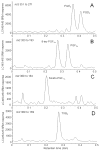Method development and validation for ultra-high pressure liquid chromatography/tandem mass spectrometry determination of multiple prostanoids in biological samples
- PMID: 23513960
- PMCID: PMC3723117
- DOI: 10.5740/jaoacint.12-280
Method development and validation for ultra-high pressure liquid chromatography/tandem mass spectrometry determination of multiple prostanoids in biological samples
Abstract
Following oxygenation of arachidonic acid by cyclooxygenase to form prostaglandin H2 (PGH2), a variety of prostanoids can be generated with diverse physiologic effects on pain, inflammation, allergy, cardiovascular system, cancer, etc. To facilitate the quantitative analysis of prostanoids in human serum of cell culture, an ultra-high pressure LC (UHPLC)/MS/MS method was developed and validated for the measurement of six eicosanoids belonging to the cyclooxygenase pathway: PGE2, PGD2, 8-iso-PGF2alpha, PGF2alpha, 6-keto-PGF1alpha, and thromboxane B2 (TXB2). Selectivity, matrix effects, calibration model, precision, and accuracy (intraday and interday), lower limit of quantitation (LLOQ), recovery, stability, and sample dilution were evaluated. Fast UHPLC separation was carried out in only 0.5 min with isocratic elution, and each prostanoid was measured using negative electrospray ionization MS with collision-induced dissociation and selected reaction monitoring. UHPLC/MS/MS provided high throughput with peak widths of approximately 3 s and an LLOQ of 0.020 ng/mL for PGE2, 0.027 ng/mL for PGD2, 0.152 ng/mL for 8-iso-PGF2alpha, 0.179 ng/mL for PGF2alpha and 6-keto-PGF1alpha, and 0.013 ng/mL for TXB2.
Figures




Similar articles
-
Nano-LC-MS/MS for the quantitation of prostanoids in immune cells.Anal Bioanal Chem. 2014 Nov;406(28):7103-16. doi: 10.1007/s00216-014-8134-8. Epub 2014 Sep 6. Anal Bioanal Chem. 2014. PMID: 25192790
-
Simultaneous quantification of PGI2 and TXA2 metabolites in plasma and urine in NO-deficient mice by a novel UHPLC/MS/MS method.J Pharm Biomed Anal. 2016 Sep 10;129:148-154. doi: 10.1016/j.jpba.2016.06.050. Epub 2016 Jun 28. J Pharm Biomed Anal. 2016. PMID: 27424195
-
Development and validation of UHPLC-ESI-MS/MS method for the determination of selected cardiovascular drugs, polyphenols and their metabolites in human urine.Talanta. 2012 Jan 30;89:47-56. doi: 10.1016/j.talanta.2011.11.055. Epub 2011 Nov 26. Talanta. 2012. PMID: 22284458
-
Rapid and simultaneous quantitation of prostanoids by UPLC-MS/MS in rat brain.J Chromatogr B Analyt Technol Biomed Life Sci. 2014 Jan 15;945-946:207-16. doi: 10.1016/j.jchromb.2013.11.041. Epub 2013 Nov 25. J Chromatogr B Analyt Technol Biomed Life Sci. 2014. PMID: 24355215 Free PMC article.
-
miRNA-protein-metabolite interaction network reveals the regulatory network and players of pregnancy regulation in dairy cows.Front Cell Dev Biol. 2024 Aug 2;12:1377172. doi: 10.3389/fcell.2024.1377172. eCollection 2024. Front Cell Dev Biol. 2024. PMID: 39156977 Free PMC article. Review.
Cited by
-
Suppression of von Hippel-Lindau Protein in Fibroblasts Protects against Bleomycin-Induced Pulmonary Fibrosis.Am J Respir Cell Mol Biol. 2016 May;54(5):728-39. doi: 10.1165/rcmb.2015-0111OC. Am J Respir Cell Mol Biol. 2016. PMID: 26488390 Free PMC article.
-
Quantification of eicosanoids and their metabolites in biological matrices: a review.Bioanalysis. 2018 Dec;10(24):2027-2046. doi: 10.4155/bio-2018-0173. Epub 2018 Nov 6. Bioanalysis. 2018. PMID: 30412686 Free PMC article. Review.
-
Anti-Inflammatory Effect of Malva sylvestris, Sida cordifolia, and Pelargonium graveolens Is Related to Inhibition of Prostanoid Production.Molecules. 2017 Nov 3;22(11):1883. doi: 10.3390/molecules22111883. Molecules. 2017. PMID: 29099738 Free PMC article.
-
Retinoid and carotenoid status in serum and liver among patients at high-risk for liver cancer.BMC Gastroenterol. 2016 Feb 29;16:30. doi: 10.1186/s12876-016-0432-5. BMC Gastroenterol. 2016. PMID: 26927700 Free PMC article.
-
The Role of Antioxidants Supplementation in Clinical Practice: Focus on Cardiovascular Risk Factors.Antioxidants (Basel). 2021 Jan 20;10(2):146. doi: 10.3390/antiox10020146. Antioxidants (Basel). 2021. PMID: 33498338 Free PMC article. Review.
References
-
- Nicolaou A. In: Bioactive Lipids. Nicolaou A, Kokotos G, editors. Oily Press; Bridgwater, UK: 2004. pp. 197–222.
-
- Yu R, Xiao L, Zhao G, Christman JW, van Breemen RB. J Pharmacol Exp Ther. 2011;339:716–725. http://dx.doi.org/10.1124/jpet.111.185405. - DOI - PMC - PubMed
-
- McAdam BF, Catella-Lawson F, Mardini IA, Kapoor S, Lawson JA, FitzGerald GA. Proc Natl Acad Sci USA. 1999;96:272–277. http://dx.doi.org/10.1073/pnas.96.1.272. - DOI - PMC - PubMed
-
- Bhagwat SS, Hamann PR, Still WC, Bunting S, Fitzpatrick FA. Nature. 1985;315:511–513. http://dx.doi.org/10.1038/315511a0. - DOI - PubMed
Publication types
MeSH terms
Substances
Grants and funding
LinkOut - more resources
Full Text Sources
Other Literature Sources

